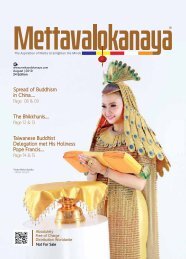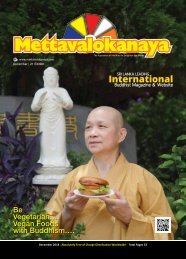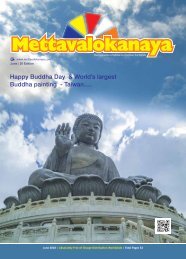Mettavalokanaya_Buddhist_Magazine_March_2019
“Mettavalokanaya” International Monthly Buddhist Magazine has been successfully distributed to 40 countries including all districts across Sri Lanka and now “Mettavalokanaya” is Sri Lankan Most Popular & Leading monthly Buddhist Magazine.
“Mettavalokanaya” International Monthly Buddhist Magazine has been successfully distributed to 40 countries including all districts across Sri Lanka and now “Mettavalokanaya” is Sri Lankan Most Popular & Leading monthly Buddhist Magazine.
You also want an ePaper? Increase the reach of your titles
YUMPU automatically turns print PDFs into web optimized ePapers that Google loves.
For those who are interested in the<br />
ordination of women, this is one of<br />
the most puzzling questions, which<br />
needs a great deal of contextual<br />
understanding. When King Suddhodana,<br />
the Buddha’s royal father passed away,<br />
the duty of a wife to her husband was<br />
completed. It was the right time for<br />
Maha Pajapati to consider following the<br />
teaching and the practice of the Buddha<br />
seriously. But, when she approached<br />
and asked for permission the Buddha<br />
simply said, “Please do not ask so.” The<br />
Tripitaka, which is the most important<br />
primary source, did not provide any<br />
reason for not allowing women to join<br />
the Order. Many interpretations were<br />
given in later commentaries trying to<br />
explain the situation. This led also to<br />
common belief that the Buddha did<br />
not want to allow women to lead a<br />
religious life. This is not without basis.<br />
According to Indian social mores, to lead<br />
“The Brighter of<br />
Bhikkhuni Sasana”….<br />
a religious life is not the path for women.<br />
Manudharma Sastra was very clear to<br />
spell out that salvation for a woman is<br />
possible only through bhakti (devotion)<br />
to her husband.<br />
But Maha Pajapati was unshaken<br />
in her decision. After the Buddha had<br />
gone, she, along with 500 Sakiyanis<br />
(Sakyan women) from the royal court<br />
shaved their heads and donned the<br />
yellow robes. ey followed him on foot<br />
until they arrived at Vesali where the<br />
Buddha resided. Upon arriving at the<br />
arama (residence) they did not ask to<br />
have an audience with the Buddha for<br />
fear of being rejected again. Ananda, the<br />
Buddha’s cousin and personal attendant,<br />
found them at the entrance covered<br />
with dust, with torn robes and bleeding<br />
feet. Many of them were miserable<br />
and in tears of desperation. He learned<br />
from them of their request and on their<br />
behalf approached the Buddha. Again,<br />
the Buddha forbade Ananda in the<br />
same manner, “Ananda, please do not<br />
ask so. There are various reasons to be<br />
taken in consideration in attempting to<br />
understand the possible difficulties or<br />
obstacles which presented themselves in<br />
the mind of the Buddha.<br />
First of all Maha Pajapati was a<br />
queen who, along with 500 ladies of the<br />
court, knew only the life of comfort. To<br />
lead a reclusive life allowing them only to<br />
sleep under the tree, or in the cave, would<br />
be too hard for them. Out of compassion<br />
the Buddha wanted them to think it over.<br />
Furthermore, accepting a large group of<br />
women to be ordained all at once would<br />
immediately involve teachers to provide<br />
them both instruction and training. The<br />
Buddha also could not make himself<br />
constantly accessible for them. The<br />
Sangha was not ready with competent<br />
teachers to handle a large crowd of<br />
women. This proved to be a reality later<br />
on when women were already accepted<br />
to the Sangha. Monks who could teach<br />
the nuns must be not only learned but<br />
also require an appropriate attitude to<br />
help uplift women spiritually.<br />
The Buddha already received<br />
criticism from outsiders for breaking<br />
up families by ordaining either the<br />
husbands or wives. When Maha Pajapati<br />
approached him with 500 Sakiyanis,<br />
definitely this would be a major cause<br />
of criticism. Particularly Sakyas did<br />
not marry people from other clans. By<br />
allowing 500 Sakiyanis to be ordained<br />
would definitely affect the social status<br />
quo. But it was revealed that these<br />
women’s husbands had already joined<br />
the Order. Thus, the criticism that<br />
accepting these women would break up<br />
their families became groundless. The<br />
fact that these women followed him on<br />
foot to Vesali is a proof of their genuine<br />
commitment to lead religious lives and<br />
removed the doubt that their request<br />
might be out of momentary impulse.<br />
These could have been some of the<br />
reasons behind the Buddha’s hesitation.<br />
The Buddha needed the time to examine<br />
both the pros and cons to their request.<br />
Ananda also tried to understand the<br />
Buddha’s refusal. Is it because women<br />
are not capable of achieving spiritual<br />
enlightenment? If that is so, then<br />
ordination, a spiritual path is open only<br />
to men. To this, the Buddha made it<br />
clear that both men and women have<br />
equal potentiality to achieve spiritual<br />
enlightenment. We have to mark this<br />
statement, as this is the first time in<br />
the history of religion that a religious<br />
leader declared openly that men and<br />
women are equal on spiritual grounds.<br />
Previously in the Hindu context, the<br />
Vedas, the most sacred religious texts,<br />
were available only to men. Buddhism<br />
has transcended race, nation, caste and<br />
gender differences to declare that the<br />
highest spiritual achievement transcends<br />
obstacles or discrimination of gender.<br />
With this important reason, the Buddha<br />
allowed women to join his Order.<br />
Theravada context which preserved<br />
the teachings in Pali. Theravadins believe<br />
that their teaching is most authentic<br />
from a historical point of view. We need<br />
to understand that the Tripitaka that we<br />
know of was not a written work from<br />
the Buddha’s time. Religious knowledge<br />
was to be practiced and handed down<br />
from teachers to chosen disciples. Hence<br />
no religious teaching was recorded.<br />
This applied also to the teaching of<br />
the Buddha. The Tripitaka was first<br />
recorded in Sri Lanka not before 450<br />
B.E. (about 90 B.C.) What was recorded<br />
was according to the understanding of<br />
the monk recorders. What they chose<br />
to record was subjective, hence it is<br />
understandable why the Tripitaka is<br />
androcentric. The Tripitaka was recorded<br />
by men who were ridden with Indian<br />
social values. They were men who by<br />
the vinaya, were expected to lead lives<br />
of purity. The most immediate obstacle<br />
“The<br />
Buddhism and<br />
Bhikkhunies”….<br />
to their chastity was the opposite<br />
gender. Many teachings as preserved by<br />
these men therefore projected women<br />
(embodiment of their obstacles) as evil,<br />
unclean, etc. This is a necessary barrier<br />
to fence themselves off from failing into<br />
the pit of the unchaste. While reading<br />
the Tripitaka one must remind oneself of<br />
this limitation in order to sift the essence<br />
from its social contextual limitations.<br />
Looking at the teaching from the<br />
Paramattha level, one sees clearly that<br />
Buddhism is free from gender bias,<br />
Buddhism is the first religion in the<br />
world to recognize the equal spiritual<br />
potentiality of men and women. This<br />
provides a special place for Buddhism<br />
which started in India to lift up to the<br />
world spiritual level without boundary<br />
in race, caste, or gender. Among western<br />
feminists, abortion is one of the most<br />
discussed social issues. One argues that<br />
a woman should have right over her<br />
body because it is hers. Buddhism does<br />
not argue on this point but takes a clear<br />
stand that abortion is killing. One who<br />
chooses abortion transgresses the first<br />
precept. But whether the government<br />
should pass a bill to legalize abortion or<br />
not is an issue which needs consideration<br />
from various related fields e.g. social,<br />
economic, cultural, etc.<br />
To the argument which raises a<br />
question whether abortion is killing “life”<br />
or not, Buddhism supplies a detailed<br />
explanation of conception and its<br />
various stage of formation. This explains<br />
the coming together of sperm and egg,<br />
then through 01st, 02nd, 03rd, 04th<br />
week to a stage called ‘Pancasakha’ or<br />
“05 branches” namely head, arms, legs<br />
Life is present through all these stages<br />
since conception. To complete killing<br />
there are at least 05 factors: 01 - that it<br />
has life, 02 - knowing that it has life, 03 -<br />
willingness to kill, 04 - try to kill, 05 - that<br />
life is destroyed. If one has completed<br />
these five factors, killing is completed<br />
bearing fruit of action (Vipakkarma). As<br />
a <strong>Buddhist</strong> woman, one may be forced<br />
to choose abortion but must be willing<br />
to receive the fruit of her action without<br />
trying to explain away the teaching to<br />
suits one’s choice. That a man should<br />
bear equal responsibility of pregnancy<br />
is true but entirely a separate issue to<br />
consider.<br />
Thailand<br />
The Chief Abbes<br />
Songdhammakalyani<br />
Bhikkhuni Arama and The<br />
Medicine Buddha Vihara,<br />
Nakhonpathom, Thailand<br />
Most Venerable Bhikkhuni<br />
Dhammananda (Dr.<br />
Chatsumarn Kabilsingh)<br />
8 l <strong>Mettavalokanaya</strong> l <strong>March</strong> l <strong>2019</strong> l www.mettavalokanaya.com www.mettavalokanaya.com l <strong>2019</strong> l <strong>March</strong> l <strong>Mettavalokanaya</strong> l 9
















